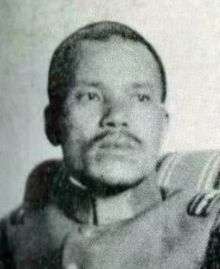Tateo Katō
Tateo Katō (加藤 建夫, Katō Tateo, September 28, 1903 – May 22, 1942) was a Japanese ace army aviator, credited with at least 18 aerial victories and who was honored posthumously by an award of the Order of the Golden Kite.
Tateo Katō | |
|---|---|
.jpg) Major General Tateo Kato | |
| Native name | 加藤 建夫 |
| Born | September 28, 1903 Asahikawa, Hokkaido, Japan |
| Died | May 22, 1942 (aged 38) Bay of Bengal |
| Allegiance | Empire of Japan |
| Service/ | Imperial Japanese Army |
| Years of service | 1925–1942 |
| Rank | Major General (posthumous) |
| Unit | Imperial Japanese Army Air Service |
| Commands held | 64th Sentai |
| Battles/wars | |
| Awards | Order of the Golden Kite |
Biography
Katō was born and raised in present-day Asahikawa, Hokkaidō.[1] His father Sergeant Tetsuzo Katō was killed in the Russo-Japanese War.[2] He graduated from the 37th class of the Imperial Japanese Army Academy in 1925, and enrolled in the Tokorozawa Flying School two years later.
In May 1927, he was posted to the 6th Hiko Rentai (flight regiment) in Pyongyang, Korea. His flying skill with the Kawasaki Ko-4 biplane fighter (a license-built Nieuport-Delage NiD 29) was so outstanding that he was selected to become a flight instructor at Tokorozawa in 1928. In 1932, Katō was promoted to head instructor at the Akeno Flying School, the premier air academy for the Imperial Japanese Army Air Force. In 1936, Kato became commander of the 5th Rentai, and with the outbreak of the Second Sino-Japanese War in 1937, he became commander of the 2nd Daitai, equipped with Kawasaki Ki-10 "Perry" biplane fighters, which quickly achieved air superiority over northern China. Katō claimed nine Chinese fighters during his rotation, making him the top-scoring Army pilot in China during the period 1937–1941.
Katō returned to Japan in 1939 to attend the Army Staff College and was assigned to the headquarters staff of the Imperial Japanese Army General Staff. He also visited Europe on assignment, together with General Hisaichi Terauchi, and inspected the Luftwaffe in Germany. During this period, he was also promoted to major.

In 1941, with the start of the Pacific War, Katō was again given a combat command – this time as commander of the 64th Sentai, based at Guangzhou, China, and equipped with the latest Nakajima Ki-43 Hayabusa fighters.[3] His unit participated in the early stages of the war, especially distinguishing itself during the Battle of Malaya. The 64th Sentai was based at Duong Dong airfield on Phu Quoc Island to provide cover for the Japanese invasion fleet bound for Malaya, and to attack ground targets in Malaya and Burma. The 64th Sentai had its first combat experience against the Flying Tigers on 25 December 1941, escorting a bomber raid on Rangoon. Under Katō's command, the unit recorded over 260 aerial victories over Allied aircraft. He disallowed individual victory credits for the sake of teamwork.[4] Katō was promoted to Lieutenant Colonel in February 1942.
On May 22, 1942, while over the Bay of Bengal, Katō was killed in action while attacking a flight of No. 60 Squadron RAF Bristol Blenheim bombers. As Kato pulled up after making his first diving pass on the Blenheims, turret gunner Flight Sergeant "Jock" McLuckie raked the fighter's exposed belly with a long burst and the Ki-43 started to burn and crashed into the sea. Katō was posthumously promoted two steps in rank to major general, and was honored by a special State Shinto ceremony at Tokyo's Yasukuni Shrine as a "god of war" in mid-October 1942.[4]
Katō's heroism had considerable propaganda value, and the Japanese government sponsored a movie titled Kato hayabusa sento-tai (加藤隼戦闘隊) (1944) glorifying his life story.
Notes
- Credibly researched bio notes + digitized photographic image
- Sakaida, Henry. (1997). Japanese Army Air Force Aces, 1937–45, pp. 27–28.
- "Tokyo Awards List Big Officer Loss; Vice Admiral, 2 Rear Admirals and 2 Major Generals Win Posthumous Honors; 55 Naval Fliers Named; Group Included Covers the Japanese Pacific Dead Up to Mid-February", The New York Times, October 16, 1942.
References
- Hata, Ikuhiko Hata (2002). Japanese Army Air Force Units and Their Aces: 1931-1945. London:Grub Street. ISBN 978-1-902304-89-2 (cloth)
- Sakaida, Henry. (1997). Japanese Army Air Force Aces, 1937-45. London: Osprey Publishing.ISBN 1-85532-529-2
- Stanaway, John. (1998). Nakajima Ki.43 "Hayabusa": Allied Code Name "Oscar." Bennington, Vermont: Merriam Press. ISBN 1-57638-141-2
External links
- "Japan's Hero's", , Time October 26, 1942.
- Biplane Fighter Aces from the Second World War: Credibly researched bio notes + digitized photographic image
- Tateo Katō at Find a Grave
- Kato hayabusa sento-tai on IMDb